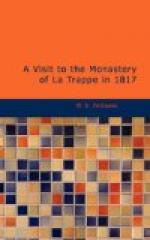Silence is at all times rigidly maintained; conversation is never permitted: should two of them even be seen standing near each other, though pursuing their daily labour, and preserving the strictest silence, it is considered as a violation of their vow, and highly criminal; each member is therefore as completely insulated as if he alone existed in the Monastery. None but the Pere Abbe knows the name, age, rank, or even the native country of any member of the community: every one, at his first entrance, assumes another name, as I before observed, and with his former appellation, each is supposed to abjure, not only the world, but every recollection and memorial of himself and connexions: no word ever escapes from his lips by which the others can possibly guess who he is, or where he comes from; and persons of the same name, family, and neighbourhood, have often lived together in the Convent for years, unknown to each other, without having suspected their proximity.
The abstraction of mind practised at La Trappe, and the prevention of all external communication with the world is such, that few but the superior know any thing of what is passing in it. It has been related, that so little information of the affairs of mankind did these people receive, that the death of Louis XIV. was not known there for years, except by the Father Abbe; and such was their state of seclusion, that a Nobleman having taken a journey of five hundred miles, purposely to see the Monastery, could scarcely find in the neighbouring villages one person who knew where it was situated. Indeed, at the present day, it is quite astonishing how little is known of this place, and how very few, even among those in its immediate vicinity, have ever visited it.[1]
On the great festivals they rise at midnight; otherwise they are not called until three quarters past one: at two they assemble in the Chapel, where they perform different services, public and private, until seven in the morning, according to the regulations of the week, as exemplified in the “Table pour l’Office Divin”. At this hour they go out to labour in the open air. Their work is of the most fatiguing kind, is never intermitted, winter or summer, and admits of no relaxation from the state of the weather.
[Footnote 1: Among the most frequent visitors of La Trappe, was the unfortunate James the Second. His first visit was on the 20th November, 1690, where he was received by M. de Rance, whose account of it is very interesting.]
When their labour is over, they go into Chapel for a short time, until eleven o’clock, the hour of repast; at a quarter after eleven they read till noon; and afterwards lie down to rest for an hour: they are then summoned into the garden, where they again work until three; then read again for three quarters of an hour, and retire for another quarter to their private meditations, by way of preparation for vespers, which begin at four, and end at six; at seven they again enter the Chapel, and at eight they leave it, and retire to rest.




